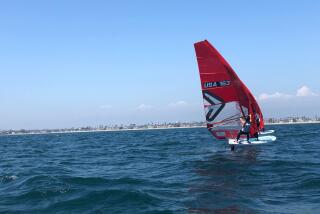New Judging System Pleases Everybody
- Share via
The best part of the on-the-water judging system introduced at last week’s Congressional Cup regatta at Long Beach was that the skippers liked it, said Tom Ehman, the chief judge.
“The second-best part is (the judges) worked from 9 to 5 and had some great parties at night,” Ehman added.
Bouncing around in a small boat in the wake of two competitors all afternoon was a small price to pay for avoiding the rancor and tedium of protest hearings at night. As a noble experiment, the system proved a cure for what has afflicted match-race sailing.
“The quality of racing is improved by it,” said Australia’s Peter Gilmour, who won the event. “At Fremantle (in the America’s Cup), I spent long hours, until 4 in the morning, sitting up waiting for a result. It’s better to get it done on the water and get your sleep.”
Gilmour, predictably, led the fleet by calling five protests, two of which resulted in penalties. He thought the yacht racing rules need to be modified for match racing to permit more aggressive tactics, and he had some qualified support.
The system was the brainchild of Ehman and two other international judges who worked the event--Goran Petersson of Sweden and Cy Gillette of Hawaii. Besides achieving its primary goal of eliminating the hearings, it produced some unexpected benefits.
Foremost was that although 19 yellow flags were popped in protest in the 45 races, all but 7 were waved off by the judges, who considered the incidents too trivial to merit a penalty. Under the old system, they would have had to hear all 19, arousing animosity among competitors and, perhaps, penalizing somebody for an infraction that really didn’t affect a race.
As eyewitnesses, the judges adopted an attitude of no harm, no foul.
“If on-the-water refereeing is going to work, they’re going to have to let the players play and get really aggressive,” said skipper John Kolius, who has worked as a basketball official.
One downside may have been that the players were intimidated by the judges breathing down their transoms.
Dick Deaver, a two-time winner of the event who served as a judge, said: “We were surprised by the lack of aggressive maneuvering before the starts. I believe the severity of the penalty needs to be fine-tuned.”
The sailors quickly learned that having to perform a 270-degree-turn penalty was too much to overcome, essentially ending a race as it had barely started. Kolius was the only one who came back to win, but only because Britain’s Eddie Owen had to re-round a mark.
But Judge Bryan Willis of Britain, who was rules adviser for Australia’s Kookaburra syndicate at Fremantle, pointed out that the skippers joined the judges before the event in voting for the more severe 270 penalty over a mere jib drop.
“They want to see that someone who is fouled gets a clear advantage,” Willis said. “The (penalized boat) can still catch up if the other guy screws up.”
Petersson learned that it’s one thing to review written and spoken testimony in a hearing room and another to make quick judgment calls, like any other sports official.
“The individual judges are more exposed,” Petersson said. “They have to have the guts to stand up and say it was their decision.”
The concept seems likely to be adopted by all major match-race sailing events, with minor modifications. One thing learned, Ehman said, was that the judges need boats with tower bridges to gain three-dimensional perspective.
Otherwise, Ehman said: “We came out of this with a near-world class performance for the first time out. The shortest call we had was 8 seconds. The longest was 20 seconds. That’s a lot shorter than a 2-hour hearing. The system is a real step forward.”
Kolius, the America II skipper at Fremantle, said: “Everyone’s intent in doing it here is to prove its success and pass it on to the America’s Cup. The reason we’re doing this is for the media and the spectators and to help our sport grow.”
More to Read
Go beyond the scoreboard
Get the latest on L.A.'s teams in the daily Sports Report newsletter.
You may occasionally receive promotional content from the Los Angeles Times.










